That's right, this is a 1944 recording of the ninth greatest female star of all time performing Aloha Oe on the musical saw. The performance doesn't begin till 1:25 in but prior to that, you get a charming introductory exchange between The Smouldering One and a rather incredulous MC... It makes me long for a parallel universe where our current crop of screen sirens have similar singular talents and we are regularly treated to recitals featuring Cate Blanchett on theremin, Scarlett Johannsen on hurdy-gurdy, and Angelina Jolie on nose flute.
(This video was introduced to me by the devilishly diverting Coilhouse)
 In 2006, sound artist Tomoko Sauvage attended a Terry Riley concert in Paris and heard an instrument that utterly entranced her - it was called the jalatharangam. As the name might suggest, it originally hails from Southern India and consists of a series of porcelain filled with water which are "played" by striking them with small bamboo rods.
In 2006, sound artist Tomoko Sauvage attended a Terry Riley concert in Paris and heard an instrument that utterly entranced her - it was called the jalatharangam. As the name might suggest, it originally hails from Southern India and consists of a series of porcelain filled with water which are "played" by striking them with small bamboo rods.
Not long after the concert, Sauvage had constructed her own jalatharangam from bowls she picked up in the local Chinatown and set to work trying to replicate classical Indian ragas on them. As she immersed herself in this new instrument, however, her focus shifted and she became fixated on the sound of the water itself; using tiny underwater microphones to capture it dripping and rippling in the individual bowls.
The recorded results of this inspired take on an ancient instrument are available as mp3 excerpts on The Wire website and as streams on the artist's website, and they are truly spellbinding. (Also, for a substance as immaterial as water, the tones produced are surprisingly strong and resonant; sounding in places like detuned bells.)
If you'd like to see how she produces these sounds, here's a video of a performance from September last year:
And if you want to hear more, keep an ear out for her debut solo album, Ombrophilia, which means "love of rain" and is due out on either/OAR later this year.
If you've been wondering why there have been no updates in the past couple of weeks, there are two reasons:
First of all, I'm off to Palestine in a fortnight to meet up with Daz who's over there working on this, so I've been busy trying to learn Arabic. (Unfortunately, the Arabic I've been learning is "classic" Arabic which seems to be rather different from what they actually speak on the streets of the West Bank, so it may not end up being that useful.)
Secondly, after coming across Mobispray, a mad mobile phone light-painting project, and discovering that the genius behind it, Jurgen Scheible, had tutorials on music programming for mobiles; I decided to build my very own mobile phone theremin using Python for Symbian S60. (That's the operating system for phones like the Nokia N95.)
Unfortunately, no one's yet built a usable module in Python to dynamically queue sounds to the audio buffer on these phones, so the best I could come up with was something that used the accelerometer to cycle through a series of prebuilt single-note midi files as I waved the phone up and down. The end result sounded like a skittish cat prancing across a piano keyboard... Cosmovox, it wasn't.
After next failing to create a gesture-based drum machine, I turned my attention to something more modest that would work and that I might actually be able to use on stage - a phone-key sampler pad.
It's not rocket science (and its no doubt all been done before), but its a damn good interface for this sort of thing... and its a lot of fun!
At present, I'm only loading predefined samples but, when I get up to speed on this Symbian stuff, I'll incorporate multiple banks of samples that can be pulled from anywhere on the phone and live recordings to specific "keys"; and I'll package it all up in an app that you can download if you like.
(NB: Where you see a red number on the key display in the video, that's a sample being looped; where it's yellow, that's a single-shot.)
 Artist Paul Rubenstein has recently been teaching kids at two Brooklyn high schools to build their own guitars from scratch; with lessons on winding home-brew pickups, microtonal fretting and DIY amp constructions. When the lessons are over, he lets them rip and the results sounds like some long lost New York no-wave artifact.
Artist Paul Rubenstein has recently been teaching kids at two Brooklyn high schools to build their own guitars from scratch; with lessons on winding home-brew pickups, microtonal fretting and DIY amp constructions. When the lessons are over, he lets them rip and the results sounds like some long lost New York no-wave artifact.
Nick, Ayonde, Hector, Rashid, Vishal and Mr. R
And you can find more tracks, images and videos of their class work here. (via WFMU)
 Washington Phillips was a Texan gospel singer who only ever recorded 16 songs back in in the late 1920's, but he has been a source of enduring musical fascination ever since. One of the main reasons for that fascination is the instrument he plays on those recordings to accompany his singing. The sound it produces is reminiscent of a battered toy harpsichord which is capable of veering from the ethereally beautiful to the completely carnivalesque, but no one knows exactly what it is.
Washington Phillips was a Texan gospel singer who only ever recorded 16 songs back in in the late 1920's, but he has been a source of enduring musical fascination ever since. One of the main reasons for that fascination is the instrument he plays on those recordings to accompany his singing. The sound it produces is reminiscent of a battered toy harpsichord which is capable of veering from the ethereally beautiful to the completely carnivalesque, but no one knows exactly what it is.
Some musicologists have speculated that it might be a Dolceola, a commercially-produced early twentieth century cross between a toy piano and zither, but according to the engineer who recorded Phillips, the instrument was a homemade creation that "nobody on earth could use except him".
Over the years, Phillips' work has appeared on a variety of compilations and has been released in full by several labels (most recently Yazoo and Mississippi). For your listening pleasure, I'm passing on two tracks that have been covered by famous fans of Phillips. (The first one appeared on a 1971 album by Ry Cooder, and the second was covered by Will Oldham's band, Palace Brothers, in 1993.)
Washington Phillips - Denomination Blues
Washington Phillips - I Had A Good Father And Mother
 In 1977, sound artist Bill Fontana took a tape recorder down to the Kirribilli ferry pier in Sydney Harbour and discovered “music” in the sounds of the waves sluicing water into bore holes on the dock. (You can hear samples of it in this Quicktime video on his site.) The recording eventually reached the ears of artist in residence at the San Francisco Exploratorium, Peter Richards, and he sought to emulate this wave-produced music by embedding PVC and concrete pipes into a jetty on San Francisco Bay; at heights where they could be reached by the incoming tide. He called this creation, the Wave Organ. Unfortunately, I haven’t managed to track down any online audio of the Wave Organ in action, but reporter Megan Edwards describes it as “like listening to the world's largest sea shell. It's like distant drums, muffled cymbals, quiet thunder.”
In 1977, sound artist Bill Fontana took a tape recorder down to the Kirribilli ferry pier in Sydney Harbour and discovered “music” in the sounds of the waves sluicing water into bore holes on the dock. (You can hear samples of it in this Quicktime video on his site.) The recording eventually reached the ears of artist in residence at the San Francisco Exploratorium, Peter Richards, and he sought to emulate this wave-produced music by embedding PVC and concrete pipes into a jetty on San Francisco Bay; at heights where they could be reached by the incoming tide. He called this creation, the Wave Organ. Unfortunately, I haven’t managed to track down any online audio of the Wave Organ in action, but reporter Megan Edwards describes it as “like listening to the world's largest sea shell. It's like distant drums, muffled cymbals, quiet thunder.”
More recently, this concept of a wave-driven instrument was incorporated into the 2005 refurbishments of the quay at Zadar in Croatia. This version, called the Sea Organ, consists of a series of whistle openings built into the steps of a promenade that descends into the Adriatic. Unlike, the Wave Organ, the dulcet tones of the Sea Organ have been well documented in YouTube videos, a downloadable mp3, and a CD that can purchased from the official site.
(via Neatorama and Metafilter)
 June 11th, 1785 found my 6 first music stones at the Tip end of North end of the long tongue.
June 11th, 1785 found my 6 first music stones at the Tip end of North end of the long tongue.
This is an entry from the journal of Peter Crosthwaite, an inveterate inventor and curator of the local museum at Keswick in the Lake District of northern England - and first devotee of the musical stones of Skiddaw. These stones, which he refers to, are pieces of hornfels from the nearby Skiddaw mountain that produced a resonant ringing tone when struck, a tone that changed in pitch depending on the size of the stone.
In all probability, Crosthwaite was not the first person to observe this phenomenon, but he was the first to think of turning it into a musical instrument. In the six months following this journal entry, he threw himself into fossicking and "tuning" his finds (by chipping away at them) until he had enough to make a sixteen note stone xylophone. This instrument then became the main attraction in Crosthwaite's museum, and he would use it to literally drum up business; banging out a tune, accompanied by his daughter and an old woman on bass drum, gongs and barrel organ, whenever a coached arrived in town.
And that's as far as it went. Crosthwaite was an ingenious eccentric, but he wasn't a terribly good self-promoter (he once let someone else take the credit for a lifeboat he invented) and an average musician at best, so for the time being, the musical stones of Skiddaw remained little more than a local curiosity.
In 1827, however, another Keswick local, Joseph Richardson, set out to change all that. A stonemason by trade, Richardson was also a gifted musician with a capacity for truly monomaniacal obsession. For 13 years, he devoted himself to building a stone xylophone with a full eight-octave range. In the process, he almost drove his family to the poor house, but his efforts were ultimately rewarded. Within a decade of its completion, Richardson's lithophone was known throughout England and he was performing musical stone recitals of Handel and Mozart for Queen Victoria.
After wowing his countrymen, he toured the continent and was all set to conquer America, when tragedy struck - his youngest son, who had blossomed into a musical stone virtuoso, contracted pneumonia and died. Richardson cancelled the tour and never played the instrument again...
It thus lay dormant until 2005 when a new generation of enthusiasts took it out of mothballs for a performance at a local arts festival. Other performances have since been organised at the University of Leeds and the 2006 Liverpool Biennial. Hopefully, these will continue and this unique instrument will once again enjoy the fame that it basked in back in the time of Joseph Richardson.
(And, if you want to hear what the stones sound like, they have a MySpace page.)
 Like many who dabbled in alchemy back in the 17th century, Avedis dreamt of one day unlocking the secret of alchemic transmutation – the art of turning base metals into gold. In 1618, this Armenian artisan who lived in Constantinople, attempted to do it with a mixture of tin, copper and silver – and basically failed. The result of his efforts was an alloy with the colour and lustre of gold, but sadly it wasn’t the genuine article. When he struck a sheet of it with a hammer, however, he discovered something almost as “valuable” as gold – it produced a rich, musical crashing sound without breaking. He had created the raw material of the modern cymbal.
Like many who dabbled in alchemy back in the 17th century, Avedis dreamt of one day unlocking the secret of alchemic transmutation – the art of turning base metals into gold. In 1618, this Armenian artisan who lived in Constantinople, attempted to do it with a mixture of tin, copper and silver – and basically failed. The result of his efforts was an alloy with the colour and lustre of gold, but sadly it wasn’t the genuine article. When he struck a sheet of it with a hammer, however, he discovered something almost as “valuable” as gold – it produced a rich, musical crashing sound without breaking. He had created the raw material of the modern cymbal.
Pretty soon, Avedis was forging it into large concave disks whose reputation as noisemakers eventually reached the ears of the sultan of the day. The sultan immediately recognised their potential, not as musical instruments, but as sonic weapons that could be used to create cacophony on the battlefield and scare the wits out of any enemy.
With a lucrative military contract in his hands, Avedis adopted the name “Zildjian”, an Armenian corruption of the Turkish word for “cymbal maker”, and set up shop as the sole supplier of cymbals to the Turkish military. In time, the army realised that this “sonic weapon” could also serve a more benign purpose – accenting the beat in its marching bands. Zildjian’s cymbals thus became a bona fide musical instrument and found a place in a martial style called Janissary music. (Here is a sample mp3 of that music.)
By the late 18th century, this music had moved beyond the battlefield and parade ground, and janissary bands, or mehteran, were accompanying Turkish ambassadors on trips to European courts. When the Europeans heard this exotically discordant music, they were enraptured and one of the first “world music” crazes was borne. It was a craze that was even taken up prominent composers like Mozart, who incorporated Turkish themes and previously unheard Turkish instruments into their work. One of the most popular and distinctive of these instruments was the cymbal.
By the early 19th century, this exotic newcomer had gone from being a faddish oddity to an acceptable part of the classical orchestra. Since then, it has also comfortably found its way into the percussion sections of almost all modern styles of music and very little trace of its exotic and unusual past remains.
Through of all of this the Zildjian company has kept turning out its product and has, in the process, become the oldest popular musical instrument company in the world.
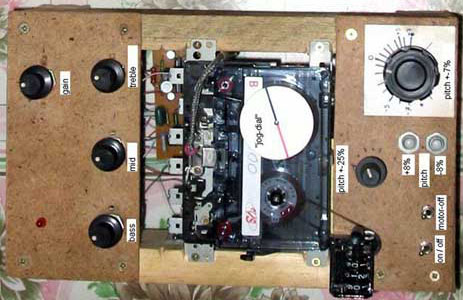
For someone like me, who once dabbled in DIY audio electronics – but never got beyond building shitty theremins and distortion units, and mounting them in Chinese takeaway containers – this is a thing of rare beauty. It’s one third of a cassette DJ set-up (not pictured is the other cassette deck and a mixer) built by Russian tinkerer extraordinare, DJ Aptem (that’s a direct transliteration from Cyrillic; apparently DJ Artyom is more phonetically correct). As you can see, it not only has EQ knobs, but a motor-off switch, a jog-dial, and fairly sophisticated collection of pitch-shifting controls. Audio samples of this set-up in action can be downloaded from DJ Aptem/Artyom’s website, and there is a photo of him in action on flickr.
 Like DJ Aptem/Artyom, Loop Orchestra rely on looped audio tape as the sole source for their music; but, in their case, there are no cleverly-modded gadgets trying to emulate modern DJ rigs. Everything is the product of a mixer and five middle-aged men threading tape loops over the spools of reel-to-reel tape machines; carefully layering them to produce hypnotically repetitive soundscapes. For the past twenty years, they have been plying their trade on the Sydney underground music scene; emerging to do a gig once or twice a year. In that time, they have released only 3 albums. The most recent one is Not Overtly Orchestal which can be purchased through Amazon. If you want to hear some of the Loopies’ work, they have Real Audio samples on their web site.
Like DJ Aptem/Artyom, Loop Orchestra rely on looped audio tape as the sole source for their music; but, in their case, there are no cleverly-modded gadgets trying to emulate modern DJ rigs. Everything is the product of a mixer and five middle-aged men threading tape loops over the spools of reel-to-reel tape machines; carefully layering them to produce hypnotically repetitive soundscapes. For the past twenty years, they have been plying their trade on the Sydney underground music scene; emerging to do a gig once or twice a year. In that time, they have released only 3 albums. The most recent one is Not Overtly Orchestal which can be purchased through Amazon. If you want to hear some of the Loopies’ work, they have Real Audio samples on their web site.
 Finally, word has reached Rummage that Alyce Santoro wants your cast-off cassettes “especially vintage mix tapes, experimental stuff, homemade recordings of local sounds, rants, raves, chants, folk and indigenous musics, stuff that maybe you've been hesitant to part with”… And what will become of your old tapes if you send them off to her? They’ll be passed on to a women’s co-operative in Nepal who will weave them into reams of fabric that will be used make shoulder bags, thangkas, and banners that you can purchase from her website. And the best thing about these pieces is that they will retain the sounds recorded on the source tapes, so if you can pull the tape-head out of an old cassette player and wire it up so it still works, you’ll be able to “play” them. (For more information about Alyce and her cassette-tape fabric creations, visit this earlier posting.)
Finally, word has reached Rummage that Alyce Santoro wants your cast-off cassettes “especially vintage mix tapes, experimental stuff, homemade recordings of local sounds, rants, raves, chants, folk and indigenous musics, stuff that maybe you've been hesitant to part with”… And what will become of your old tapes if you send them off to her? They’ll be passed on to a women’s co-operative in Nepal who will weave them into reams of fabric that will be used make shoulder bags, thangkas, and banners that you can purchase from her website. And the best thing about these pieces is that they will retain the sounds recorded on the source tapes, so if you can pull the tape-head out of an old cassette player and wire it up so it still works, you’ll be able to “play” them. (For more information about Alyce and her cassette-tape fabric creations, visit this earlier posting.)
 When you’re the cashed-up auteur behind the Lord Of The Rings trilogy and you’ve got a spare $100,000 lying around, what do spend it on? How about a cabinet containing a banjo, guitar, bass, drum kit, piano, accordion, and 24-pipe organ; all controlled by a MIDI-triggering touch screen and optimised to churn out a chirpily mechanical version of A Day In The Life?
When you’re the cashed-up auteur behind the Lord Of The Rings trilogy and you’ve got a spare $100,000 lying around, what do spend it on? How about a cabinet containing a banjo, guitar, bass, drum kit, piano, accordion, and 24-pipe organ; all controlled by a MIDI-triggering touch screen and optimised to churn out a chirpily mechanical version of A Day In The Life?
This is what Peter Jackson just splurged his money on. Apparently, it was an Xmas gift for his wife, and one can only hope that she’s more impressed with it than he is. (Check out this video where he gives a prompted thumbs up then spends the rest of the time with his back to the camera while the attending rep’s smile fades…) Maybe, he should’ve invested in one of the company’s slick-looking calliope wagons instead. (via Music Thing)
 While you’re waiting for the release of the live CD of Symphony #13 by veteran NYC art-rock guitarist Glenn Branca, which was recorded in New York, back in October, with 80 guitars, and 20 basses and drums; you might want to check out one of his more inspired pieces of axe modification – the double bodied guitar. (via Music Thing)
While you’re waiting for the release of the live CD of Symphony #13 by veteran NYC art-rock guitarist Glenn Branca, which was recorded in New York, back in October, with 80 guitars, and 20 basses and drums; you might want to check out one of his more inspired pieces of axe modification – the double bodied guitar. (via Music Thing)
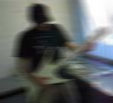 Considering that there are a significant number of Germans who yearn to be buried to the strains of AC/DC and Metallica, it comes as no surprise to learn that a pair of wacky interface design students from that country have come up with a sampler that is controlled... by headbanging.
Considering that there are a significant number of Germans who yearn to be buried to the strains of AC/DC and Metallica, it comes as no surprise to learn that a pair of wacky interface design students from that country have come up with a sampler that is controlled... by headbanging.
Using a helmet with built-in accelerometers, Bangarama is able match the volume and speed of a guitar sample to the vigorousness of the banging. To enhance the experience, the inventors - Laszlo Bardos and Stefan Korinek from the Media Computing Group at RWTH Aachen University - have built a guitar-shaped sample selector which "would act as a "airguitar" simulation - a instrument which is widely used by headbangers".
Right now, as you can see from these videos, the design of Bangarama is fairly rudimentary, and frankly rather... unrock. Thankfully, Laszlo and Stefan are aware of this and have plans to "install a long haired wig on the helmet to maximize the "rockness" of Bangarama".
If you ask me, this is an idea whose time has come; and in less than a year, I expect to see videogaming arcades everywhere filled with the flailing tresses of young metalheads jerking away to its inevitable offspring, Headbang Headbang Revolution. (via We Make Money Not Art)
 If the human mind can conceive it, and human hands can build it, some boffin somewhere will find a way to wire it up with sensors and turn into a MIDI-triggerin’ musical interface. This won’t last forever though... Eventually, we will reach a point where every household appliance and piece of home furnishing is wired for sound art. By then, however, the brainiacs will probably have moved on, and have airborne clouds of buzzing nano-speakers to play with. And one can only imagine the sort of Pandora’s Box that that will open up…
If the human mind can conceive it, and human hands can build it, some boffin somewhere will find a way to wire it up with sensors and turn into a MIDI-triggerin’ musical interface. This won’t last forever though... Eventually, we will reach a point where every household appliance and piece of home furnishing is wired for sound art. By then, however, the brainiacs will probably have moved on, and have airborne clouds of buzzing nano-speakers to play with. And one can only imagine the sort of Pandora’s Box that that will open up…
But, I digress... Of all the innovative musical interfaces that are currently being thunk up (and if you want to keep abreast of them, then Near Near Future is the place for you) the Tone Ladder strikes me as particularly inspired. (And I’m obviously not alone in this, as it was recently nominated for the 2004 Europrix Multimedia Top Talent Award.) In a nutshell, it’s a set of step-ladders with sensor-laden rungs that can be used to trigger music and/or video loops, so performances of this wondrous device end up looking like carefully-executed games of solo vertical Twister... And, if you ask me, that’s a vast improvement on watching the tablecore brigade sit at their laptops and click mouses, doodle on Wacom tablets, or wave their hands over motion detectors. The most recent outing for the Tone Ladder was at a showcase evening for the Berlin chapter of Dorkbot, a global online and meat-meet community devoted to home-brew electronic art/device tinkering and computer-based audiovisual boffinery…
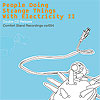 Which segues nicely into making mention of People Doing Strange Things With Electricity Too, a free online album of works by Seattle dorkboticians that was released on Comfort Stand back in late January. The collection is good snapshot of the sorts of amateur experimental electronica that are coming out of that city. My personal picks from the 25 tracks on offer are Ninnie’s dusty skipping-vinyl country drift track, Pretty Polly; Chenard Walcker’s Electricity (mainly because it has samples of the Captain Beefheart song of the same name); and Marcus Alessi Bittencourt’s Brazilian capoeira inspired collage… But that’s just me… Transmission over.
Which segues nicely into making mention of People Doing Strange Things With Electricity Too, a free online album of works by Seattle dorkboticians that was released on Comfort Stand back in late January. The collection is good snapshot of the sorts of amateur experimental electronica that are coming out of that city. My personal picks from the 25 tracks on offer are Ninnie’s dusty skipping-vinyl country drift track, Pretty Polly; Chenard Walcker’s Electricity (mainly because it has samples of the Captain Beefheart song of the same name); and Marcus Alessi Bittencourt’s Brazilian capoeira inspired collage… But that’s just me… Transmission over.
 The Murtogh D. Guinness Collection is an example of an eccentric life-long obsession that is pursued so thoroughly that it becomes a valuable and significant history of the object(s) obsessed over. In Guiness’ case, it was antique mechanical musical instruments and automata. In 50 years of collecting, he amassed nearly 700 music boxes, fairground organs, clockwork driven dolls, and self-playing instruments – some of them dating back as far as the 16th century. Ever since his death in 2002, the collection has been housed at the local museum in Morristown, New Jersey, whose website includes video/music clips of such highlights as a flute-playing doll, an automatic banjo, a 108 pipe Orchestrophone, and an animated musical ring. (via Boing Boing, and the NY Times. Free reg required.)
The Murtogh D. Guinness Collection is an example of an eccentric life-long obsession that is pursued so thoroughly that it becomes a valuable and significant history of the object(s) obsessed over. In Guiness’ case, it was antique mechanical musical instruments and automata. In 50 years of collecting, he amassed nearly 700 music boxes, fairground organs, clockwork driven dolls, and self-playing instruments – some of them dating back as far as the 16th century. Ever since his death in 2002, the collection has been housed at the local museum in Morristown, New Jersey, whose website includes video/music clips of such highlights as a flute-playing doll, an automatic banjo, a 108 pipe Orchestrophone, and an animated musical ring. (via Boing Boing, and the NY Times. Free reg required.)
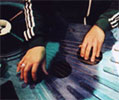 Continuing on with the experimental instrument theme, here’s Walter Kitundu, a sound artist who specialises in modified turntables. He's constructed turntables that are powered by wind, water, fire, earthquakes and even pigeons, but his most stunning creations have resulted from fusing turntables with traditional stringed instruments like the harp, koto, kora and sarangi. (In these hybrids, the record stylus effectively acts as a "pickup" for the vibrations of the strings.) His website contains images of his many wonderful instruments along with Quicktime clips of some quite lovely jazzy/folktronic music produced on the “workhorse” of the collection, the phonoharp. (via Metafilter)
Continuing on with the experimental instrument theme, here’s Walter Kitundu, a sound artist who specialises in modified turntables. He's constructed turntables that are powered by wind, water, fire, earthquakes and even pigeons, but his most stunning creations have resulted from fusing turntables with traditional stringed instruments like the harp, koto, kora and sarangi. (In these hybrids, the record stylus effectively acts as a "pickup" for the vibrations of the strings.) His website contains images of his many wonderful instruments along with Quicktime clips of some quite lovely jazzy/folktronic music produced on the “workhorse” of the collection, the phonoharp. (via Metafilter)
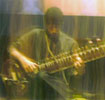 New Interfaces for Musical Expression is an annual conference where boffins from university media labs around the world deliver papers on current projects and show off all manner of nifty new experimental musical instruments and midi controllers. The website of this year’s conference, which was held in Shizuoka, Japan, has a complete set of the papers, which cover subjects like as optical turntables, eye-movement-triggered music software, Bluetooth-enabled taiko drumsticks, and something called a SillyTone Squish Factory. (Warning: High tech-speak content.) If these become too heavy-going, you can always just head over to the video/image gallery and enjoy clips of some of the performances. These include a laptop and electronic sitar trio (included in highlights clip), a live Gameboy composition, the ever-faithful pairing of violinist Mari Kimura and the GuitarBot, a two-person wind instrument called a Tooka, and Uriko Fujii’s “formula for orgasm between human and technology” which involves hair-bowing and a drum with a burst skin.
New Interfaces for Musical Expression is an annual conference where boffins from university media labs around the world deliver papers on current projects and show off all manner of nifty new experimental musical instruments and midi controllers. The website of this year’s conference, which was held in Shizuoka, Japan, has a complete set of the papers, which cover subjects like as optical turntables, eye-movement-triggered music software, Bluetooth-enabled taiko drumsticks, and something called a SillyTone Squish Factory. (Warning: High tech-speak content.) If these become too heavy-going, you can always just head over to the video/image gallery and enjoy clips of some of the performances. These include a laptop and electronic sitar trio (included in highlights clip), a live Gameboy composition, the ever-faithful pairing of violinist Mari Kimura and the GuitarBot, a two-person wind instrument called a Tooka, and Uriko Fujii’s “formula for orgasm between human and technology” which involves hair-bowing and a drum with a burst skin.
 Even if there were no audio to accompany this, it would be worth posting just for the OTT techno-hippy jargon that J M Nasim conjures up to describe his music. Apparently, its “entheogenic, deep space, techno-shamanic, pansensual vibrations… a post-industrial, paleotribal synaesthetic, timeless & harmonic polyrhythmatrix”.
Even if there were no audio to accompany this, it would be worth posting just for the OTT techno-hippy jargon that J M Nasim conjures up to describe his music. Apparently, its “entheogenic, deep space, techno-shamanic, pansensual vibrations… a post-industrial, paleotribal synaesthetic, timeless & harmonic polyrhythmatrix”.
Basically, he plays a jaw’s harp into a bank of signal processors and creates the sort of trancey, ambient twang-and-burble that you’d expect to hear on a live stage at some Earthcore rave-in-the-bush. Or, if you prefer: “various programmatic, architectonic sound spaces frame rhythmic zones within which certain acoustic potentialities reside. These sonic holograms manifest my musical explorations as shape-shifted sound. Seminal acoustics are gestated into new aural forms to birth multi-dimensional soundscapes of interpenetrating pulses and harmonics.”
An album of these “multi-dimensional soundscapes of interpenetrating pulses and harmonics” is available from CD Baby, who also have lo-fi streaming excerpts from all of the tracks on it. (via Metafilter)
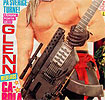 One of my current favourite new sites is Music Thing, a music-making gearhound weblog filled with mouthwatering reviews of flash new gizmos, detailed gear-wise dissections of notable recordings, homages to arcane musical apparatuses like the Teleharmonium, and tongue-in-cheek profiles of some of the more excessive moments in instrument/device design… Recently, its been focusing on guitar-design madness with a list of “ten guitars shaped like guns” (including a flamethrower-mounted guitar used by former Alice Cooper guitarist, Kane Roberts) and links to the truly bizarre collection at Ed Roman Guitars… In Ed’s catalogue, there is an Elven wood sculpture disguised as a double-necked guitar, a pair of ZZ Top commissioned fur axes, and the ultimate cock-rock instrument – the Wang Dang Wangcaster (Warning: possibly NSFW)
One of my current favourite new sites is Music Thing, a music-making gearhound weblog filled with mouthwatering reviews of flash new gizmos, detailed gear-wise dissections of notable recordings, homages to arcane musical apparatuses like the Teleharmonium, and tongue-in-cheek profiles of some of the more excessive moments in instrument/device design… Recently, its been focusing on guitar-design madness with a list of “ten guitars shaped like guns” (including a flamethrower-mounted guitar used by former Alice Cooper guitarist, Kane Roberts) and links to the truly bizarre collection at Ed Roman Guitars… In Ed’s catalogue, there is an Elven wood sculpture disguised as a double-necked guitar, a pair of ZZ Top commissioned fur axes, and the ultimate cock-rock instrument – the Wang Dang Wangcaster (Warning: possibly NSFW)